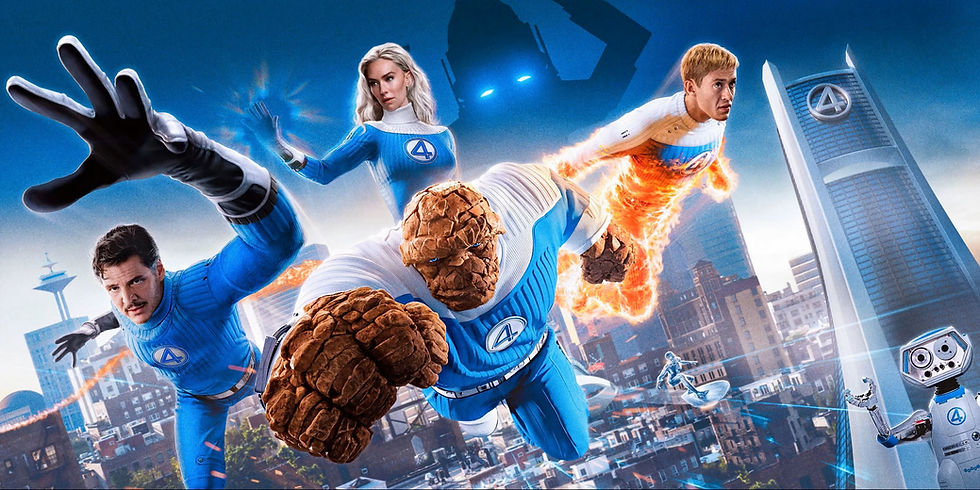A Great Big Beautiful Tomorrow
- keijimuramoto
- Sep 21, 2020
- 3 min read
Updated: Oct 5, 2020
Tomorrowland (2015) is highly underappreciated. Of Disney's newer projects, this is one film that I believe will develop a cult following in the near future. Of The Iron Giant (1999) and The Incredibles (2004) director Brad Bird's live-action projects, I prefer this film over Mission: Impossible - Ghost Protocol (2011). The three lead performances from George Clooney, Britt Robertson, and Raffey Cassidy are all rock-solid, the visual effects and production design are Oscar-worthy, the three leads' journey to their destination is intriguing at every turn (Clooney and Cassidy's arc is the most compelling), and the themes of good old-fashioned optimism for the future fit right in with Walt Disney's vision for the future. Had this movie been made in the 1960s, without all the state-of-the-art visual effects, this would have become an instant classic. I will be covering specific plot points in this review, so consider this your official Spoiler Warning.
Tomorrowland follows Casey Newton (Robertson), an optimistic teenager, as she finds a mysterious pin that, upon touching it, gives her a glimpse of a wondrous eutopia filled with possibility called Tomorrowland. She then encounters Athena (Cassidy), a charming young girl with extraordinary abilities (more on that later), who then leads her to Frank Walker (Clooney), a once-hopeful inventor turned cynic, as they make their quest to Tomorrowland, but not all is as it seems...
Casey's ever-cheerful demeanor has a grounded yet enthusiastic appeal to her that is made well-rounded by Robertson, even if some of the dialogue she is given isn't always the most well-realized. On the other end of the personality spectrum, Clooney's hardened yet emotionally dynamic performance is brought to life very well, with the right amount of levity in his presence to make himself believable within the film's universe. Cassidy's performance as the eternally youthful Athena exudes a kind of warmth, intelligence, and maturity that is not only scene-stealing but beyond her years. The fact that Athena is an Audio-Animatronic herself makes Cassidy's performance that more impressive. As mentioned earlier, Clooney and Cassidy's arc is the most compelling one in the film. They both share a history, going back to when Clooney's Frank was a child, thus it never felt creepy nor awkward given Athena's character, and the actors' age difference doesn't overshadow the experience, which is both bittersweet and a little heartwrenching.
In the words of fellow film critic Chris Stuckmann, "Tomorrowland isn't part of a franchise, a sequel, or a reboot, so it wins points for originality." That is where this movie shines the brightest. The production design for the 1960s Space Age and futurist-inspired sets, props, and gadgets have an incredible amount of creative energy put into each design, which looks and feels like a throwback and tribute to the can-do spirit that Walt Disney exuded during that period. This was especially true when Disney worked on EPCOT (Experimental Prototype Community of Tomorrow), his never-completed passion project that would inspire the Walt Disney World Resort theme park of the same name. The visual effects are stunning. The passion and skill put into creating the vibrant hustle and bustle of retrofuturist innovation within Tomorrowland are without a doubt, Oscar-worthy. I am surprised that this film didn't get nominated in 2016, because it would have been a real contender.
The film is not without its downsides, though. Once the main characters arrive in Tomorrowland during the third act, they are greeted by David Nix (played by Hugh Laurie), Tomorrowland's leader. From there, the movie takes a sudden left turn into predictability, as it involves a thematic and literal battle of beliefs between hope and despair. This is not without its moments though, as the film presents several compelling arguments for skepticism about humanity's numerous and considerable failures, but also leaving us with enough room for making our arguments. However, the execution is very ham-fisted and could have gone for a more nuanced approach without the need for spectacle-driven fight scenes.
Even though the film begins to feel somewhat predictable by the third act, the buildup is still worth the ride. From the performances, the themes, visual effects, and production design, this is a whole-hearted throwback to a simpler time in Disney's history (with the aid of modern sensibilities and visuals).
Final Score: 8 out of 10





Comments